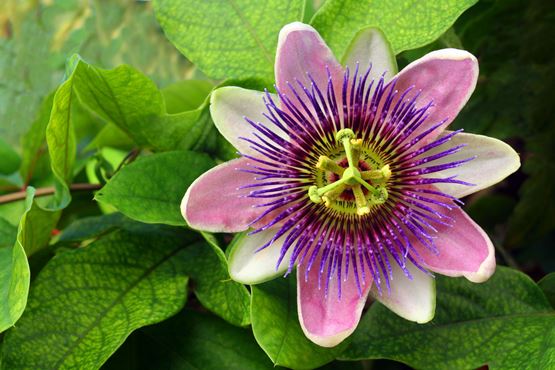 View from My Back Steps
View from My Back Steps
By
John I. Blair
Passion in a Pot
I live in the South and have lived here more than half a century. Things are different here than they were in Kansas where I’m originally from. One of the many differences is the vegetation. In Texas we have azaleas, we have magnolias, we have camellias (or at least a few people do). And we also have a rather strange and often quite beautiful plant called passionflower.
Unlike azaleas, camellias, and at least some of the magnolias, passionflowers are a native plant here. A wildflower in some areas. It’s attractive to butterflies and hummingbirds. It’s attractive to people. But until recently I had never hosted a passionflower in my home garden.
There are so many varieties of passionflower (more than 550) I have no idea what kinds grow here in north Texas (most are from Mexico and central America). But they’re pretty, when you see them. So, a couple of years ago at a sale of native plants, I purchased a tiny passionflower in a plastic pot and brought it home. I placed it alongside other potted plants. And proceeded to forget about it.
When I finally remembered it again, at first I thought the passionflower had died. That year it produced only a couple of leaves, lost under the thriving plants next to it.
Purple Passion Flower amid Green Leaves
|

|
The next year, there was more action – a plant maybe eight inches tall with a dozen leaves. The vining qualities (little curling tendrils that grabbed anything in the vicinity) were obvious. Still no flowers. And the third year it got yet a bit bigger, climbing up a nearby ironweed with a tall, sturdy stem. Still no flowers.
This year it has started running rampant, ranging across several pots and using whatever vertical stuff it finds as an improvised trellis. Looks like my passionflower is here to stay – except it’s still growing out of a little pot about the right size to grow a bunch of parsley. And still no flowers, which were the original motive for growing it at all. Three years of this makes it about time for me to stop being lazy and learn something more about Passiflora – the Latin name for the genus.
“They are mostly tendril-bearing vines, with some being shrubs or trees. They can be woody or herbaceous. Passion flowers produce regular and usually showy flowers with a distinctive corona. The flower is pentamerous and ripens into an indehiscent fruit with numerous seeds.” So – time to dig out my dictionary. “Herbaceous” means perennials that die to the ground each year. I already knew that. A “corona” means a fringelike crown of floral parts. “Pentamerous” means a flower that consists of five parts. “Indehiscent” means the fruit does not open at maturity to discharge its seeds. Wow.
Passiflora umbilicata (tendril)
|
sm.jpg)
|
“Tendril” I already knew, because I’ve grown morning glories and have long been plagued by lots of invasive vines that wrap little “arms” around the stems of other plants in order to climb. (Instead of wrapping their entire selves as do, for example, ivy and honeysuckle and Cocculus carolinus.)
Most importantly, I learned that my kind of passionflower needs lots of sunshine before it will bloom. So my next project, likely, will be to move it from my partly shaded patio to my sunny front garden and provide it something to climb on, like a trellis. That would be nice!
I have a little sprig of passionflower on my desk to look at while writing this. The leaf is dark green and has five irregular lobes, the largest about an inch in length. The tendril for climbing comes out two inches and ends in a very tightly curled “spring” because it never found anything to wrap around.
Footnotes: Passionflowers get their names because many people find Christian religious symbolism in the shape of the flower. Some passionflowers bear edible fruit (passionfruit) that can occasionally be found in grocery stores, either fresh or in various processed forms, including fruit juice. But be warned – other passionflowers bear poisonous fruit.
Click on author's byline for bio and list of other works published by Pencil Stubs Online.
|